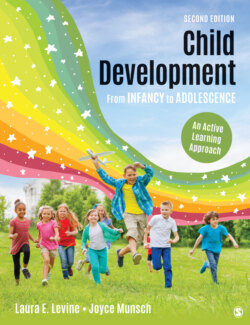Читать книгу Child Development From Infancy to Adolescence - Laura E. Levine - Страница 246
На сайте Литреса книга снята с продажи.
Infant States
ОглавлениеAlthough newborn senses are all functioning, they have a limited capacity to process information from the environment, so they have a set of infant states that helps them regulate the level of stimulation they receive and keeps the sensory input at a level they can process. Infant states are organized into two sleep states (quiet sleep and active sleep) and four awake states (drowsy, quiet alert, active alert, and crying) that reflect different levels of activity and alertness (March of Dimes, 2003).
Infant states: Different levels of consciousness used to regulate the amount of stimulation an infant receives, ranging from crying to deep sleep.
Infant states. Infants continually move through a series of states that allow them to regulate the amount of stimulation that they receive. Can you see how this is an adaptive way for an infant to meet his or her needs for rest, stimulation, and physical care?
Photo courtesy of Ted Ketai
Comstock/Thinkstock
iStockphoto.com/EMPPhotography
Most newborns experience a period of quiet alertness shortly after they are born. Their eyes are open and they are attentive to what is going on around them, but their bodies are very still and their breathing is regular. This is a wonderful opportunity for new parents to begin the process of bonding with their infant. This initial period of quiet alertness is usually followed by a state of quiet sleep. Newborns typically sleep 16 to 18 hours each day (Hanrahan, 2006). About half this time is spent in REM (rapid eye movement) sleep, which is when dreams occur, and half is spent in regular sleep, which ranges from drowsiness in which the eyes open and close to a deeper sleep in which the infant is quiet and doesn’t move. Because infants’ stomachs are so small, they wake up to eat about every 3 or 4 hours throughout the day and the night (Hanrahan, 2006).
Although sharing a family bed is a common practice in many cultures around the world, co-sleeping has been a controversial topic in the United States (Sobralske & Gruber, 2009). The American Academy of Pediatrics ([AAP], 2011c) is critical of this practice because of its relationship with sudden infant death syndrome (SIDS) and other sleep-related causes of infant death. The AAP recommends that infants sleep in the same room as their parents for at least 6 months and ideally up to a year, but that they sleep on a separate surface with a firm mattress with no soft bedding (Task Force on Sudden Infant Death Syndrome, 2016).
The last state on the continuum is crying, which is how infants signal that they need something, although they also may cry for no discernible reason. The amount of time spent crying and fussing is high during the first 6 weeks of life, with an average of about 2 hours a day, but drops significantly to a little over one hour a day by 10 to 12 weeks after birth (Wolke, Bilgin, & Samara, 2017).
Even at this young age, there are individual differences in how regular infants are in their behavior. Some have regular and predictable schedules and are easy to calm when they are upset, but others are more variable in their schedule and more difficult to soothe. Some infants smoothly transition from one state to another, and others move rapidly or unexpectedly between states. Some signal what they need in a way that is clear and easy for parents to interpret so they can promptly respond, and others are much more difficult for new parents to “read.” We discuss these temperamental differences in Chapter 7, but over the early weeks, parents come to know the unique characteristics of their newborn, and in most cases, parents and newborns are able to get in sync with each other so things go relatively smoothly. That doesn’t mean, however, that there won’t be plenty of nights with too little sleep for the new parents and times when they worry about how well they and their new baby are doing.
